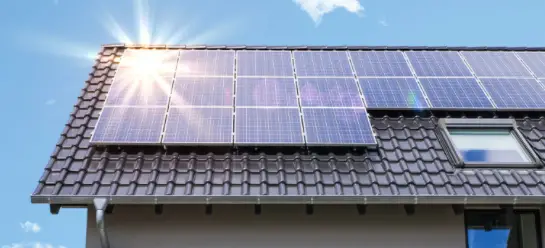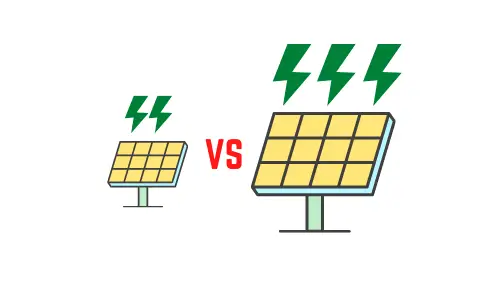Solar panel usage can be advantageous, but when it's time to figure out how much power they need, and how much it's going to cost.
In this guide, let's break down the numbers when comparing solar panel size vs output so you have a better understanding on how to configure your next solar project and the estimate cost.
How Much Solar Power Will You Need & # Of Panels Required
On average, 877 kWh / month is needed for a US household to match the annual 10649 kWh per year. (More official details here)
To determine your average power consumption, simply look at the meter or past utility bills to be more accurate for your specific situation.

First, we need to figure out how much power you're using.
To determine your RV or home's average power consumption, simply look at the meter or past utility bills.
To calculate how many solar panel you need simply do the following:
Total power consumption (kW) / Panel wattage per panel = # of panels needed
Assume kW During peak sunlight hours for your specific location)
Size VS Output
If total power needed is 5kW, the difference would be either 20 250W panels or 16 300W panels.
The size of the solar panel proportionally relates to the number of solar cells inside the panel as well as the rated watt hours.
A larger panel has more room to absorb the sunlight that convert to energy. When multiple large solar panels are connected together, they can also absorb more sunlight at a faster rate.
The larger the solar panel size doesn't necessary mean higher output if the type of the cell delivers poor performance.
Different solar panel types yield different efficiency and output ratings. Monocrystalline panels have the highest efficiency but cost the most compared to polycrystalline.
Each type has its own unique advantages and disadvantages, and please keep in mind that your best setup depend on your property and desired performance.
Cost VS Value
Higher efficiency solar panels will cost more and deliver the performance period. The cost is justified by the value you get over the lifecycle of your solar system setup.
No one wants poor efficiency or panels that can't keep up the power usage.
Solar Panel Output

Output matters for home owners to save money.
250 - 400 Watts per panel is typically a good output for solar panels.
Solar panel output is presented in number of watt-hours produced by a panel in ideal sunlight and temperature conditions.
A Watt Hour is a unit of measurement for power over 1 hour.
Example: 100 Watt light bulb on a 500 Watt Hour battery equal 5 hours
What Determines the Power Output of a Solar Panel?
The price of the panel is generally based on the dollar to watt ratio. In another word, a solar panel's total wattage plays a significant part in the overall cost analysis.
The amount of electricity the solar panel can produce is based on:
- Type of cell
- Efficiency of the cells
- Number of cells inside the panel
- Number of panels
Solar panel output is presented in number of watt-hours produced by a panel in ideal sunlight and temperature conditions.
Weather, surface condition and sunlight exposure can affect the output if they aren't maintained.
We can't control the weather, but we can do our best to maintain and clean the solar panel to keep it working at their peak performance.
Efficiency Rating
Most solar panels are between 15 and 19% efficient, and there are some outliers as high as ~22% in some high end products.
Most consumers consider solar panel efficiency to be the most important spec when accessing a product's quality, but more important than that is how efficient it can be while maintain low cost.
The more efficient the more the panel can product electricity than less efficient panel, and that's determined by the quality of the solar cells.
- Cell composition
- Electrical configuration
- Surrounding component
- and more
Type of Panel
There are 3 main types of solar panels:
- Amorphous
- Monocrystalline
- Polycrystalline
Monocrystalline is the most efficient panel for its size. To learn more about their differences please click here.
Number of Solar Cells
More solar cells = Higher wattage
The most common solar panels have photovoltaic cells arranged in a configuration of the following:
32, 36, 48, 60, 72 and 96
Most residential solar panels today are among: 60, 72, and 96.
A 60-cell panel has an average dimension 3.25ft X 5.5ft
A 72-cell panel has 5.4ft X 3.25ft
A 96-cell panel is a 5.2ft X 3.45ft, typically manufacturers use smaller 5" cells in 96 cell panels in similar size to an average 60 cell panel.
Note: The exact frame size will vary from manufacturer to manufacture.
Take Aways
- Check your electrical bills to estimate how much power you need to determine how many panels you need
- Size & quality solar panel matter
- Type of solar panel and solar cells matter
- Average US household consumes about 800 - 900 kWh / month
- Weather and surface condition does affect
Common FAQ
How Much Energy Does a Solar Panel Produce Per Square Foot?
Take the wattage rating of the panel / Size of the panel in square feet.
For Example: 300 Watt (17.31 Sq Ft) panel, 300/17.31 = 17.33 W/Sq ft
Or just read the spec sheet to make your life easier
How Many Solar Panels Do You Need to Produce 1,000 kWh Per Month?
Example: Assume using 250 W panels, 30 days in a month, 6 peak sun hours/ day
1000 kWh / 30 = 33.33 kWh / day
33.33 kWh / 6 hrs = 5.55 kW
Since real world isn't perfect, so we will compensate roughly 20% more.
0.2 X 5550 W + 5550W = 6661 W
6661 W / 300W = 26
If using 300W panel, you only need 22
Can Solar Output Vary from Place to Place Due to Geographic Location?
Solar output can vary based on geographic location.
The output will be decreased in regions with low light conditions, cloudy sky and any other factors that minimizes sun light exposure. (Think about Alaska's strange sunset & sunrise timeline during the winter)
How To Determine Average Hours of Sunlight In My Area
Please check out Solar Resource Data from www.nrel.gov
They provide sunlight information by state for major cities including maps that outline global horizontal solar irradiance on both an annual basis and monthly basis.
Check out the map and see how your region performs.
Can You Increase a Solar Panel’s Output or Efficiency?
You can't change the sky above you or immediately change where you live, but you can do a few small things at your best ability to squeeze the performance out of the solar panels that will make a big difference.
- Solar Panel Angle
- Solar Panel Surface Maintenance
- Repair or replacement when it's time to do so
How is a Solar Panel’s Rating Calculated?
Here is how you calculate the solar panel efficiency rating:
First calculate this:
Incident radiation flux (the amount is sunlight that hits the earth’s surface in your area) X dimension of your panel (square meters).
Then
(Panel wattage / the number above ) X 100 to get efficiency rating.
Most solar panels have efficiency ratings of around 15-18%.
What Items Will a 100-Watt Solar Panel Run?
A 100-watt solar pane can run most appliances and small electronic gadgets such as laptop and other devices. Please learn more in this guide - What Can a 100-Watt Solar Panel Run?

